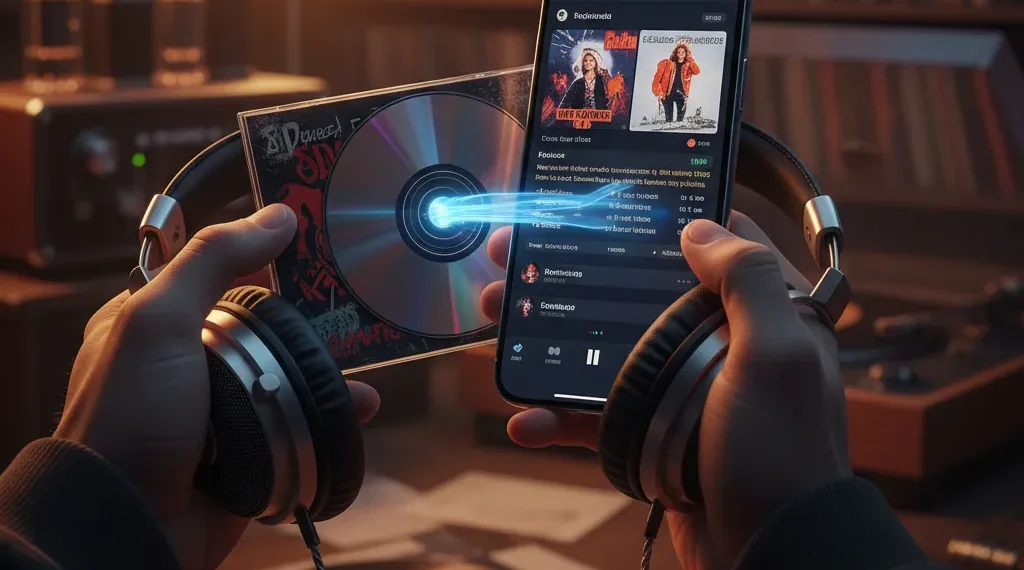Introduction: Decoding the CDiPhone Phenomenon
In a world increasingly dominated by streaming services and digital-only libraries, the concept of a CDiPhone—the speculative fusion of a smartphone with the playback or archival capabilities of Compact Discs—has emerged from the depths of tech forums and audiophile conversations.8 It is not an official product, nor is it a standard piece of terminology. Instead, cdiphone is a powerful keyword representing a deep, high-intent user frustration: How do I seamlessly integrate my beloved, high-fidelity physical CD collection with the mobile convenience of my Apple iPhone?
This keyword is a cultural artifact, a rallying cry for physical media enthusiasts who refuse to abandon their meticulously curated music libraries for the perceived lower quality or fleeting nature of streaming. To understand the CDiPhone, we must move beyond the fantasy of a disc-slot-equipped smartphone and explore the practical, conceptual, and accessory-based realities that give this unique search term its gravity and commercial potential.
Beyond the Fantasy: What Users Really Mean by CDiPhone
The intent behind the search term cdiphone falls squarely into the “Commercial Investigation” and “Informational” categories. Users are not just asking “what is it?”; they are actively seeking solutions to a media-integration problem. The concept crystallizes into three main, practical interpretations:
1. The Direct-Connect Accessory (The CDiPhone Hardware Bridge)
The most literal interpretation of the term is a physical adapter or external drive designed specifically for iOS devices.9 Since the iPhone lacks a standard USB-A port for connecting traditional external CD drives, this solution typically involves:
- USB-C or Lightning Compatibility: An external drive that uses a certified Lightning or USB-C adapter (like the Apple Camera Adapter) to physically plug into the iPhone or iPad.10
- Power Requirements: Since iPhones cannot power a standard optical drive, this solution often requires a powered USB hub or a specific, low-power optical drive.
- App Ecosystem: A third-party iOS application capable of recognizing the external drive for either ripping or direct playback, circumventing Apple’s native software limitations.
While technically challenging due to power draw and operating system restrictions, the “CDiPhone Hardware Bridge” is the core commercial interest for users searching this term.
2. The High-Fidelity Ripping Workflow (The Digital CDiPhone Solution)
For many audiophiles, the true value of a CD is its potential for a lossless, high-resolution digital file (like FLAC or ALAC) that far surpasses standard streaming quality. The cdiphone in this context refers to an optimized, quality-focused workflow.11
This approach focuses on the best software and settings to achieve a “CD quality” experience on the iPhone:
- Ripping Software: Utilizing software like XLD (on Mac) or Exact Audio Copy (EAC on PC) to create bit-perfect, error-corrected rips.
- Codec Choice: Converting the raw CD data to Apple Lossless Audio Codec (ALAC) for native iOS compatibility and storage.
- Seamless Syncing: Developing a method to efficiently transfer and manage these large, high-quality files using third-party file managers or specialized cloud services, bypassing the limitations of standard iTunes/Finder synchronization. This addresses the desire for a “CD experience” without needing the physical disc on the go.12
3. The Cultural Symbol (Nostalgia Meets Innovation)
As a cultural keyword, cdiphone symbolizes the ongoing tension between media ownership and subscription services. The term acts as a lens through which consumers express their desire for:
- Tangibility and Ownership: The pleasure of owning physical media, reading liner notes, and collecting album art.13
- Archival Security: Knowing that a personal collection is safe from service changes, licensing disputes, or network failures.
- Audio Purity: The commitment to the best possible sound quality, often perceived to be inherent in the physical format.
This symbolic power is what drives the keyword’s search volume, as it touches on a universal nostalgic trend that has also revived vinyl records.
Building Your Personal CDiPhone Experience: A Practical Guide
For users determined to bridge their physical collection with their iPhone, here are the three essential steps, moving from the physical concept to the digital reality:
Step 1: Mastering the Ripping Process (The True CD Quality)
To achieve a true “CDiPhone” experience, you must treat your initial rip as an archival process:
- Choose Lossless: Always rip to a lossless format. While FLAC is the gold standard for pure fidelity, ALAC (Apple Lossless Audio Codec) is the practical choice for seamless integration with the iPhone’s ecosystem.
- Verify Accuracy: Use software that performs C2 error checks and database verification (like AccurateRip) to ensure the digital file is an exact, bit-for-bit replica of the original disc. This is the difference between a high-quality rip and a fast, low-quality transfer.
- Metadata is Key: Properly tag all metadata (Artist, Album, Track Number, Genre, and most importantly, high-resolution Album Art). This step is crucial for the “CD experience,” turning a collection of files into a beautifully browsable library on your iPhone.
Step 2: Selecting the Right Mobile Playback Tools
The native Music app is sufficient for ALAC files, but for the true cdiphone user, third-party apps often offer greater control, better file management, and superior high-resolution playback capabilities:
- Hi-Res Player Apps: Applications that bypass the standard iOS audio path (if necessary) and offer custom equalization or high-resolution format support (DSD, FLAC beyond 16-bit/44.1kHz).
- External DAC/Amplifier: For the ultimate audio experience, the most authentic CDiPhone setup involves an external portable Digital-to-Analog Converter (DAC) and headphone amplifier. This bypasses the iPhone’s internal components, allowing the high-quality digital file to be converted to analog sound with maximum fidelity, completing the commitment to CD-grade sound on a mobile device.
Step 3: Future-Proofing the Collection
The lasting legacy of the CDiPhone keyword is its focus on long-term ownership. Your digitally archived collection is an asset.
- Redundancy: Store the master ALAC/FLAC files on at least two separate, reliable external hard drives or cloud storage services.
- Curate, Don’t Stream: Engage with your collection. The unique intent of the cdiphone enthusiast is to have a curated, owned library, not just access to the entire catalog of the world. Organize playlists, revisit old favorites, and let the physical act of owning the music inform your listening experience.
Conclusion: The Enduring Significance of CDiPhone
The CDiPhone may never be a physical product sitting on a shelf, but its persistence as a highly searched keyword confirms a powerful trend: the rejection of purely ephemeral media. It represents the informed user’s pursuit of quality, ownership, and nostalgia in a convenience-first digital landscape.14
By understanding the true intent behind the term—the desire for a seamless, high-fidelity bridge between a physical CD library and the iPhone’s mobility—users can build a custom setup that delivers the archival security and audio purity they crave. The CDiPhone is not a gadget; it is the ultimate personal music ecosystem, expertly curated and optimized for the highest possible quality on the world’s most popular mobile device.










